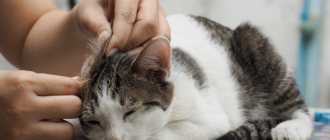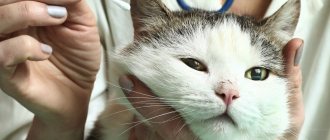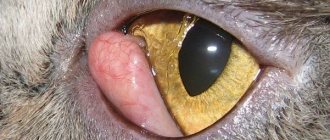Harmless reasons
Cats at a young age are susceptible to various types of injuries, ranging from falls from heights to blows during play. We don’t even need to talk about street animals; they constantly live in a high-risk area.
The appearance of a bump on the head of such pets can be caused by the following reasons.
Fight
With other cats or even dogs (pets can also get it from a parrot). After serious fights, bumps, bites and lots of scratches are considered common.
In most cases, everything heals and passes without a trace. Deep, open wounds, especially in the head area, require urgent care.
A bite of an insect
Even domestic cats cannot be 100% protected from bites from fleas, ticks, wasps, flies and even ants. If the bite is localized in the head area, then it is quite possible that a soft lump will appear.
A characteristic feature is redness of the skin and severe itching. After wasp stings, there can be enormous swelling and pain in the affected area. It is imperative to inspect the bite site and remove the sting if it remains. For severe swelling, taking antihistamines (Suprastin, Zyrtec) is indicated.
Foreign body
A splinter can be a splinter from a wooden floor or a needle from a plant (cactus or rose). In most cases, a soft lump the size of a pea forms at the site where the foreign body enters. An inflammatory process may develop with redness and suppuration of the lesion.
Removing the splinter and treating the inflamed area with an antiseptic solution (Chlorhexidine, Dioxidine) almost always solves the problem. There is also the option that the foreign body will be covered with skin and a small bump will be felt in this place, which can be left untouched.
Metal objects, glass fragments or syringe needles require urgent removal in a hospital setting.
Some allergic reactions can be considered harmless causes, provided that they go away on their own after eliminating the source of the allergen.
Diagnostics
In such situations, correct diagnosis is very important. The veterinarian will definitely perform an ultrasound on your pet.
- To begin, the veterinarian visually examines the pet and palpates the sore area.
- Then ultrasound and radiography are performed.
- To conduct a thorough cytological and histological examination, it is necessary to take pieces of tumor tissue - a biopsy.
- In addition, blood and urine are collected for additional laboratory testing.
In addition, the veterinarian will refer the animal for blood and urine donation.
- Wen usually does not cause symptoms, but requires professional intervention due to the risk of developing into liposarcoma. This is a malignant tumor and can lead to death for your pet.
- Benign formations also do not manifest themselves in any way.
- Abscesses formed as a result of bites, scratches, and scratching are accompanied by severe itching and possible hyperthermia.
- Allergic reactions, in addition to constant itching, are characterized by possible vomiting due to intoxication.
We invite you to read: Use of the drug amoxoil for the treatment of infections in cats
An owner who is concerned about the condition of his pet should bring him to a competent specialist for examination. The veterinarian will conduct a number of mandatory studies:
- First, the doctor must carefully examine the animal.
- Next, he will ask the cat's owner questions about her health.
- Afterwards, general laboratory tests are carried out, which include blood and urine tests.
- If a specialist cannot diagnose a disease based on the test results, he will prescribe an ultrasound scan for the animal.
In addition to ultrasound, CT is also prescribed. These diagnostic methods allow the veterinarian to determine the degree of infiltrative neoplasm.
In rare cases, it becomes necessary to conduct a study of the cat's immune system. This diagnosis helps the specialist make the correct diagnosis. After all, lipoma symptoms often appear in various immunodeficiency states of pets, as well as in leukemia.
Responsible cat owners who discover wen or other growths on the back or other part of the body of their pet quickly go to the veterinarian. Diagnostics is carried out comprehensively and therefore gives the most accurate result.
- First, the doctor will examine the cat, the size and color of the formations, and determine their density and pain.
- Then an x-ray or ultrasound may be prescribed.
- Cytological and histological examination is important. Skin particles are taken from the cat in the area of the tumor. A biopsy in such cases is mandatory.
More conventional tests are also performed - blood and urine. Each type of diagnosis is important; the results of all complement each other and allow an accurate diagnosis to be made.
Determining the exact cause that triggered the formation of scabs on a cat’s neck can only be determined by a qualified veterinarian. First of all, the doctor collects an anamnesis, determining when the first characteristic signs of lesions appeared.
Perhaps the appearance of itching and sores is seasonal, or the animal is on medication.
Next, laboratory tests are prescribed - a general clinical blood test, blood biochemistry, and a biopsy from the affected areas of the skin. Of no small importance in diagnosing sores on a cat’s neck is an examination under a special ultraviolet lamp.
If pyoderma is suspected, scrapings from the damaged parts and smears are performed for further examination under a microscope.
Possible pathologies
Unfortunately, not all causes of a bump on a cat’s head may be harmless.
There are also pathologies that require immediate surgical intervention or adequate drug treatment.
Papillomas
They appear mainly in adults after 7 years of age. At the initial stage, it may look like a small growth the size of a bead. As the process progresses, it may increase to the size of a walnut.
If the papilloma is of viral origin, then there is a good chance that it will disappear without a trace on its own. Formations that prevent the animal from leading a normal life must be removed.
If the papilloma is constantly injured, bleeds and ulcerates, then it is recommended to remove it as quickly as possible. Today this can be done using laser, coagulation or cryodestruction. The method is selected based on the localization of the formation.
Neoplasms
There are benign and malignant. Benign tumors are characterized by a gradual increase in size, absence of ulceration, and metastasis to other organs and bones.
The problem can only be solved surgically by excision of the formation within healthy tissue. The surgeon may decide not to touch small wen after cytology and no growth.
Malignant tumors are characterized by aggressive growth and constant bleeding. Using diagnostic measures (puncture and cytological examination), the nature of the formation is determined - squamous cell carcinoma or sarcoma. Next, a head CT scan and radiography are shown.
In the case of metastases in the skull, the prognosis is unfavorable. In the absence of metastases, the tumor is surgically removed using healthy tissue (at the surgeon’s discretion). And even if such an operation is successful, the prognosis is cautious, since this is a head problem.
Eosinophilic granuloma
A common type of allergic reaction to food (most often), flea bites, tick bites and exposure to chemicals. In 90% of cases they appear in the form of multiple dense nodules.
When it appears on the head, you can feel several lumps the size of a hazelnut. The solution to the problem is to eliminate the allergen that provokes the reaction. If this is not done, the number of granulomas may increase, and ulcers will appear in their place as the process progresses. Consultation with a dermatologist for eosinophilic granulomas is mandatory.
Features of treating wen in a pet
A soft lump on a cat's back is a lipoma. It is quite easy to distinguish it from an abscess and other neoplasms; you just need to grab the lump with two fingers. In this case, the lipoma or wen will easily roll under the skin, and the cat will not feel any discomfort. The formation of wen is caused by the accumulation of sebum. They form a soft capsule that is shaped like a ball.
Lipomas themselves are not dangerous at all and do not cause discomfort to cats. Their appearance is due to endocrine disorders or natural aging of the pet. Nevertheless, veterinarians recommend removing lipomas, as there is a risk of the benign lump degenerating into a malignant neoplasm.
There is only one treatment option for lipoma in a cat - surgical removal. Owners of pets with this pathology have to agree to surgery if the wen limits the animal’s movements. Also, you should not refuse the procedure if the cat constantly scratches the tumor that is bothering him with his claws.
If a specialist recommends leaving the wen alone, then the cat’s owner will have to constantly monitor any changes that will occur in the future with the neoplasm. This is the only way to notice in time its significant increase or degeneration into cancer.
The operation to remove a wen in a cat is as follows:
- First, the surgeon makes a small incision.
- If the tumor is small, it can be easily removed without additional manipulation.
- If the wen is very large, massive drainage will be required.
- During removal of an infiltrative tumor, it is necessary to excise the affected muscle tissue.
After the operation, the cat will have to take non-steroidal and sedative medications for some time to help the animal’s body recover faster.
If the operation was complex and after it the cat cannot move independently, then she must be given a drip with a solution that helps prevent dehydration.
It is very important to monitor the cat's condition during the postoperative period. It is necessary to ensure that the animal under no circumstances throws off the tight bandage. The pet should not be allowed to independently lick the wound received during surgery.
The veterinarian will explain to the cat's owner how to properly treat a wound on the animal's body. It is worth listening to the recommendations of a specialist. It is necessary to ensure that the damaged area remains covered with a bandage until the pet recovers completely. Otherwise, an infection may get into the wound, which will significantly slow down the cat’s recovery after surgery.
Lump on a cat's head photo
In conclusion, I would like to remind you that even young cats need to be carefully examined for neoplasms at least once a month. This should be done especially carefully in the first two months after estrus and in cats over 10 years old.
Results of treatment of lipoma in a cat
Veterinarians claim that after removing a wen from a pet in the postoperative period, the risk of relapse of the disease is very small. The reappearance of a lipoma should not be ruled out if it belonged to the group of infiltrative neoplasms.
Under no circumstances should you try to remove a wen on a cat’s body on your own. If such seals are detected, you should immediately contact an experienced specialist. Only he can find out how dangerous the lipoma is and whether it is worth removing.
The main symptoms of lipoma in a cat are swelling and small bumps on his body, located under the skin. They have a round or oval shape. Wen can be felt quite easily. The disease has no other symptoms.
First aid and treatment for cats
As a rule, first aid and treatment of a cat in such cases is the prerogative of a veterinarian. We can advise the owners themselves the following:
- It is necessary to immediately provide the animal with complete rest; if necessary, it should be isolated from other pets and small children.
- If the lump has formed suddenly, you can apply cold in the first half hour to an hour. Do not use warming or cooling ointments.
- To make paw care and treatment easier, you can clip the hair around the coat.
- If pus or other exudate is released from the neoplasm, it must be regularly removed from the skin.











